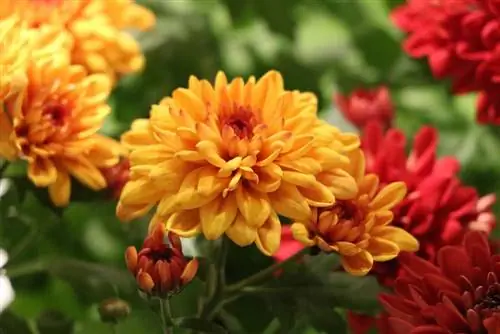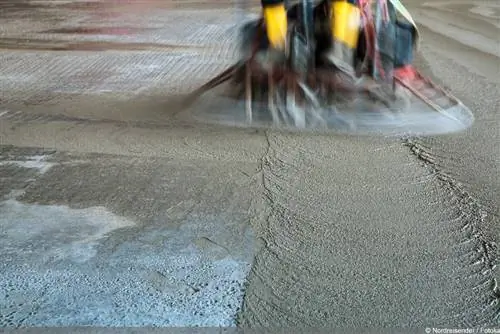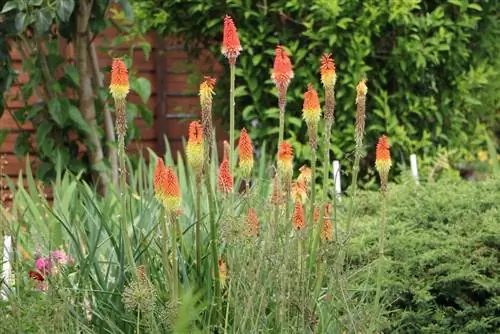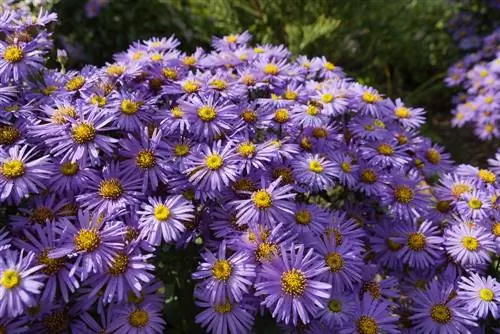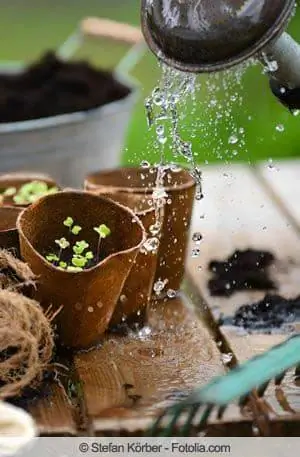- Author admin [email protected].
- Public 2023-12-17 03:39.
- Last modified 2025-01-24 12:45.
There are plants that have been planted on the balconies in autumn for a long time and again and again for a long time: they get along well with the volume of soil in the usual balcony box, bloom until winter, are willing to grow and are easy to care for. With these, autumn planting and decoration can be done in no time at all, with lasting success:
The traditional autumn beauties
Of these traditional autumn beauties, we will not introduce you to the current trend varieties that flood the trade in autumn and which are often disposable plants - you see them on every corner. There are some classic autumn beauties for the balcony and terrace that will give you rich autumn blossoms and will delight you for much longer than the varieties most commonly found in stores:
Asters: blue-flowered, in a rich variety
decorate well into October:
- Cushion aster, Aster dumosus, loose cushion-shaped growth and rich flowers in blue, red-blue, purple, needs nutritious soil and sun
- Smooth-leaf aster, Aster novi-belgii, grows taller than the cushion aster, otherwise similar effect and needs
- Rough leaf asters, Aster novae-angliae, original relatives of the ones just mentioned, same requirements
- Wildaster, Aster ageratoides, forms carpets with many small flowers even in partially shaded locations
- Blue forest aster, Aster cordifulius, habitus and location like wild aster, develops large blue star flowers
- White forest aster, Aster divaricatus, see above, delightful white sea of flowers with even more obvious star blossom
Chrysanthemums: Chrysanthemum=the gold flower, gold flower
Chrysanthemums “illuminate” balconies and terraces even on foggy days well into November with flowers in golden yellow, orange, red, pink and various copper tones. The “gold flowers” (translation: “chrysanthemum”) are available in different heights for balcony boxes and pots, and they also offer a wide variety of flower shapes, simple, semi-double and double flowers, large and small flowers, anemone-flowered, pompom-flowered and spider-shaped varieties. All of this with exemplary frugality, which makes care child's play. However, not all chrysanthemums are hardy, not even all Chrysanthemum-indicum hybrids, here are the good and very good winter-hardy varieties selected by the perennial selection working group at Weihenstephan-Triesdorf University:
- Chrysanthemum indicum, the original autumn or winter chrysanthemum, hardy and persistent with flower colors in all shades of gold
- Chrysanthemum 'Anastasia', also 'Anja's Bouquet', rich-flowered, pink-violet
- Chrysanthemum 'Arcadia', dark salmon pink flowers, large and richly flowered
- Chrysanthemum 'Bienchen', small golden yellow flowers with orange-brown center
- Chrysanthemum 'Bronze Carpet', brown-red medium-sized flowers
- Chrysanthemum 'Chamoisrose' blooms salmon pink with strong color change
- Chrysanthemum 'Citronella' flowers lemon yellow
- Chrysanthemum 'Corinna' blooms intensely purple-violet
- Chrysanthemum 'Hebe', flowers in a delicate violet pink, very richly flowered
- Chrysanthemum 'Autumn Brocade', bronze-colored flowers, very richly flowered
- Chrysanthemum 'Autumn Bronze', small amber flowers
- Chrysanthemum 'Herbstrubin', large flower in deep ruby red
- Chrysanthemum 'Autumn Sonata', large and pink-violet flowers
- Chrysanthemum 'Raspberry Red' with attractive, raspberry-red, rather isolated flowers
- Chrysanthemum 'Isabellarosa', delicate salmon-colored flowers, large-flowered and richly flowered
- Chrysanthemum 'Julia', many small flowers in delicate pink
- Chrysanthemum 'Carmine Silver', large thick flowers in burgundy red
- Chrysanthemum 'Little Amber', apricot-colored, quite large flowers in very large numbers
- Chrysanthemum 'Lightdome', lots of simple light yellow flowers that turn pink as they bloom
- Chrysanthemum 'Lübeck', brown-red flowers with ocher tips
- Chrysanthemum 'L`Innocence', delicate violet-pink flowers in very large numbers
- Chrysanthemum 'Mary Stocker', pale orange flowers with play of colors, richly flowered
- Chrysanthemum 'Mei-kyo' shows small, light pink-purple flowers in large quantities
- Chrysanthemum 'Mist Rose' does not bloom very numerously, but beautifully in a delicate pink
- Chrysanthemum 'Oury', bright burgundy flowers with bright yellow center
- Chrysanthemum 'Rehauge', small red-brown flowers that turn pink when they bloom
- Chrysanthemum 'Romantica', many large flowers that look like tuffs in very light pink
- Chrysanthemum 'Rumpelstiltskin', thick brown-red heads with golden yellow center
- Chrysanthemum 'Schaffhausen', lots of lemon-yellow flowers that really put you in a good mood
- Chrysanthemum 'Schlosstaverne', small purple flowers that look a little "ruffled"
- Chrysanthemum 'Schneesturm' (=snow cloud), creamy white, looks quite elegant
- Chrysanthemum 'Switzerland Bronze', bronze-red large flowers in abundance
- Chrysanthemum 'Switzerland', shows many flowers in dark pink-violet
- Chrysanthemum 'Twinkle', lots of plush purple flowers
- Chrysanthemum 'Vesuv', large deep wine-red flowers with sunny yellow interior
- Chrysanthemum 'Vreneli', rusty red flowers that sit in quartets or quintets on the branch
- Chrysanthemum 'White Mist Rose' (=gemstone), white flowers with light yellow interior
- Chrysanthemum 'White Giant', white double flowers that look very natural despite their considerable size
- Chrysanthemum 'Lightdome', flowers in light ruby red with distinctive rich yellow pistil
- Chrysanthemum 'White Bouquet', lots of creamy white tuff with a delicate yellow center
- Chrysanthemum 'Yellow Satellit' or 'Spider' would look like a spider with its flower tips if there were lemon-yellow spiders
- Chrysanthemum 'Zinnenbalken', creamy white, large-flowered, richly flowered - noble
The Perennial Classification Working Group has classified 41 of 99 chrysanthemum varieties examined as good to excellent winter hardiness - the majority of the chrysanthemums that are usually sold as hardy only cope well with the winter in the German garden, and even less withstand the winter in the balcony box. Chrysanthemums with the nickname “× grandiflorum” or “hortorum” are also sold as hardy, but they are not always so. In these garden chrysanthemums, chrysanthemums from warmer Asian climates were also crossed with C. indicum. This list illustrates very well how important it is to purchase goods from a specialist store, with precisely described goods about which expert salespeople can provide information. Buy potted and container plants from a specialist nursery that stocks Rehauge', 'Romantica' or 'Rumpelstiltskin' chrysanthemums - instead of just any anonymous chrysanthemum that will quickly die out on your balcony. Purchasing from specialist retailers is almost never more expensive than from profit-oriented “I-deal-in-everything” retailers. On the contrary, when you buy locally you save on shipping costs and get plants that have not suffered from shipping (and the specialist nursery pays the taxes Unlike some “I-deal-in-everything” traders too).
Heather herbs, but the right ones
Of our native common heather, genus Calluna, there is only one species, Calluna vulgaris. It is the dominant plant species of the heathland, where it grows on quite acidic soil. But even on nutrient-poor soil, as long as the substrate is not particularly calcareous, the frugal dwarf shrub thrives in any balcony box. If you buy the right varieties from specialist retailers:
- Calluna vulgaris, red, pink or white flowers, classic common heather with long flower spikes
- Calluna vulgaris 'Skyline', new calluna that grows upright like a small cypress with white-pink flowers
- Calluna vulgaris bicolor, green-red autumn and winter bloomers
- Calluna vulgaris tricolor, flowers green, pink, red, autumn and winter
The callunas are replaced in flower by heather herbs of the genus Erica, which are available in around 850 species. Most of them have developed in South Africa and do not cope well with our winter weather and winter light; only a few Erika feel at home here, e.g. E.g.:
- English heather, Erica x darleyensis, grows broadly upright, flowers white, pink, red from November to May, only hardy in mild locations
- Oldenburg Heath, Erica x oldenburgensis, frost-hardy heather, several varieties
- Snow heather, Erica carnea, blooms from December to March in many varieties
- Transylvania heather, Erica spiculifolia, is loved by bees, blooms from May and is cut back again in August/September, so frost hardy that the pot can freeze through
There are heathers that you should keep away from your balcony if you want to plant unproblematic, frost-hardy plants: the currently popular tree heather Erica aborea, the gray heather Erica cinerea, the South African Erica verticillata with the great bright pink flowers, the Cornwall Heath 5. Erica vagans and the bell heather Erica gracilis - none of which are hardy here, and the pretty Erica tetralix is a pure moor heather, for extreme locations with pH values below 4.5. The heather herbs like sun and partial shade and are all more than undemanding. When they have finished flowering, they are cut back.
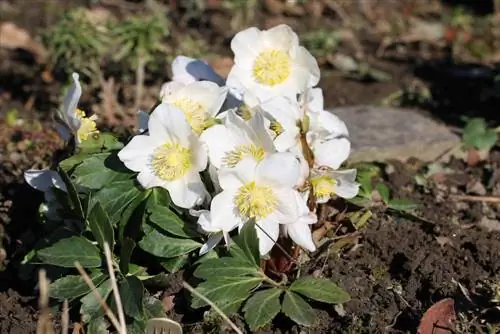
The magical Christmas rose
Helleborus niger is one of our few evergreen native plants. The robust perennial is easily hardy and exceptionally decorative, a great plant for autumn decorations. The Christmas rose harmonizes excellently with heather plants, prefers partial shade, usually grows in the shade and, if well cared for, becomes more beautiful every year over a long period of time.
- Real Christmas rose, Helleborus niger, 12 cm tall, easy-care, frost-hardy balcony plant
- Variety “Christmas Star”, a little taller than the average Christmas rose, develops larger flowers
- 'Goldmarie' shows extra large white flowers from the end of October until winter
- 'Cinnamon Snow' develops abundant flowers from white to cinnamon pink from November onwards
Christmas roses need fairly deep pots/balcony boxes, it should be around 50 cm.
Decorate your balcony and terrace for autumn
All of these plants will accompany you for years and are planted as young plants at a distance so that they have room to develop. You can use these gaps for autumn decoration, with which every balcony box and every pot becomes its own little autumn landscape: The ingredients for natural autumn decoration are available for free on your next autumn walk: autumn-colored leaves, cones, small branches with red berries, pieces of moss can be placed on small ones Floral foam cushions are attached and placed in the gaps in the boxes/pots so that the young plants grow in a similar protection as in the forest floor.
Conclusion
Planting balconies and terraces for autumn is quick and easy with classic autumn bloomers. You create a permanent planting that will delight you for a long time - there is a reason why heather and the like have become the most popular autumn plants. That was the basis, more ideas for autumn planting and decoration await you in the other articles about autumn, balconies and terraces.

